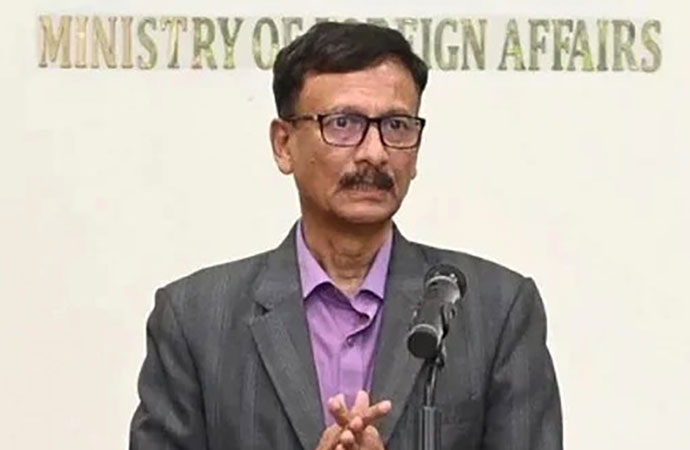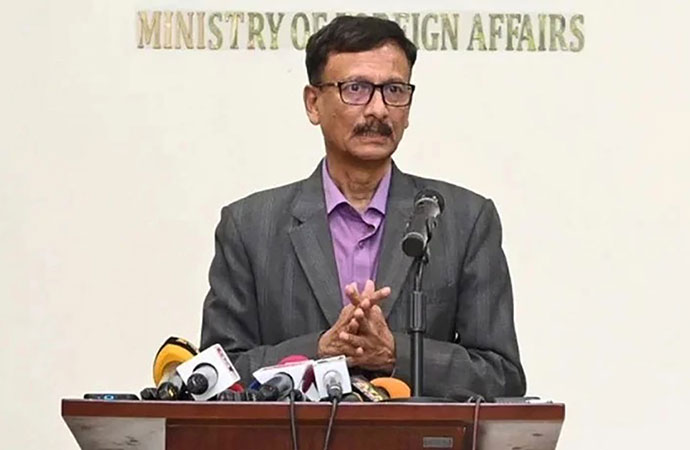Reportage

Prime Minister Sheikh Hasina, in a recorded video message, addresses the opening session of the two-day ‘Leaders’ Summit on Climate’ on Thursday, April 22, 2021. Photo: Collected
On Earth Day 2016, the landmark Paris Agreement was signed by the United States, China, and some 120 other countries. This signing satisfied a key requirement for the entry into force of the historic draft climate protection treaty adopted by consensus of the 195 nations present at the 2015 United Nations Climate Change Conference in Paris. Then came Donald Trump, and America's subsequent exit from the treaty.
With a nod no doubt to that same date five years on, and determined to show that the United States is again serious about cutting pollution of heat-trapping gases with a new goal for reducing emissions, President Joe Biden convened leaders of the world's most powerful countries, plus important ones in the climate fight, on Thursday to try to spur global efforts against climate change, drawing commitments from Chinese President Xi Jinping and Russian President Vladimir Putin to cooperate on cutting emissions despite their own sharp rivalries with the United States.
"Meeting this moment is about more than preserving our planet," Biden declared, speaking from a TV-style set for a virtual summit of 40 world leaders. "It's about providing a better future for all of us," he said, calling it "a moment of peril but a moment of opportunity."
"The signs are unmistakable. the science is undeniable. the cost of inaction keeps mounting," he added.
Biden's own new commitment, timed to the summit, is to cut U.S. fossil fuel emissions up to 52% by 2030. marking a return by the U.S. to global climate efforts after four years of withdrawal under President Donald Trump. Biden's administration is sketching out a vision of a prosperous, clean-energy United States where factories churn out cutting-edge batteries for export, line workers re-lay an efficient national electrical grid and crews cap abandoned oil and gas rigs and coal mines.
Japan announced its own new 46% emissions reduction target Thursday, and South Korea said it would stop public financing of new coal-fired power plants, as the U.S. and its allies sought to build momentum via the summit.
The coronavirus pandemic compelled the summit to play out as a climate telethon-style livestream, limiting opportunities for spontaneous interaction and negotiation. The opening was rife with small technological glitches, including echoes, random beeps and off-screen voices.
But the U.S. summit also marshalled an impressive display of the world's most powerful leaders, alongside representatives of those most vulnerable, speaking on the single cause of climate change.
Prime Minister Sheikh Hasina, in her role as chair of the Climate Vulnerable Forum, on put forward four suggestions to global leaders to fight climate change challenges with a strong collective response.
The premier made the suggestions in her prerecorded video message screened in the opening session. Her suggestions include - announcing an immediate and ambitious action plan by developed countries to reduce their carbon emissions to keep the global temperature at 1.5 °C with focus on mitigation measures; and ensuring the annual target of $100 billion which should be balanced 50:50 between adaptation and mitigation with a special attention while pursuing losses and damages.
The other two suggestions are, major economies, international financial institutions and private sectors should come forward with plans for concessional climate financing as well as innovation; and focusing on green economy and carbon neutral technologies with a provision of technology transfer among nations. (See the story after next)
MOVERS AND SHAKERS
China's Xi, whose country is the world's biggest emissions culprit, followed by the United States, spoke first among the other global figures. He made no reference to nonclimate disputes that had made it uncertain until Wednesday that he would even take part in the U.S. summit, and said China would work with America in cutting emissions.
"To protect the environment is to protect productivity, and to boost the environment is to boost productivity. It's as simple as that," Xi said.
Putin, whose government has been publicly irate over Biden's characterization of him as a "killer" for Russia's aggressive moves against its opponents, made no mention of his feuding with Biden in his own climate remarks, a live presentation that also saw moments of dead air among production problems.
"Russia is genuinely interested in galvanizing international cooperation so as to look further for effective solutions to climate change as well as to all other vital challenges," Putin said. Russia by some measures is the world's fourth-biggest emitter of climate-damaging fossil fuel fumes.
However, Russia and China announced no specific new emissions cuts themselves.
The pandemic made gathering world leaders for the climate summit too risky. That didn't keep the White House from sparing no effort on production quality. The president's staff built a small set in the East Room that looked like it was ripped from a daytime talk show.
Biden and Vice President Kamala Harris addressed the summit from separate lecterns before joining Secretary of State Anthony Blinken and White House climate envoy John Kerry at a horseshoe-shaped table set up around a giant potted plant to watch fellow leaders' livestreamed speeches.
The format meant a cavalcade of short speeches by world leaders, some scripted, some apparently more impromptu. "This is not bunny-hugging," British Prime Minister Boris Johnson said of the climate efforts. "This is about growth and jobs."
The Biden administration's pledge would require by far the most ambitious U.S. climate effort ever, nearly doubling the reductions that the Obama administration had committed to in the landmark 2015 Paris climate accord. German Chancellor Angela Merkel was one of many allies welcoming the U.S. back into the accord after Trump pulled out, boosted oil and gas production and mocked the science underlying climate warnings.
"I'm delighted to see that the United States is back, is back to work together with us in climate politics," Merkel declared in her virtual appearance. "Because there can be no doubt about the world needing your contribution if we really want to fulfill our ambitious goals."
The new urgency comes as scientists say that climate change caused by coal plants, car engines and other fossil fuel use is worsening droughts, floods, hurricanes, wildfires and other disasters and that humans are running out of time to stave off catastrophic extremes of global warming.
Leaders of smaller states and island nations buffeted by rising seas and worsening hurricanes appealed for aid and fast emissions cuts from world powers.
"We are the least contributors to greenhouse gas emissions, but the most affected by climate change," said Gaston Alfonso Browne, prime minister of Antigua and Barbuda. He called for debt relief and more international assistance to recover from storms and the pandemic to prevent a flow of climate refugees.
His people he said, are "teetering on the edge of despair."
After the stream of solemn pledges on fighting climate change, the talk turned to money. Developing countries were watching for firm financial moves from the United States, which they say still owes $2 billion in aid for transitioning away from fossil fuels that President Barack Obama promised but Trump didn't pay.
Biden delivered new pledges, saying the U.S. would double climate funding help for less wealthy countries by 2024. That cost would be more than made up for when "disasters and conflicts are avoided," he said. The U.S. International Development Finance Corporation would make a third of all its new investments climate-focused within two years, he said.
Other speakers urged hefty taxes on climate-damaging polluters and a slashing of government programs that amount to subsidies for oil, gas and coal.
Longtime climate policy experts, no strangers to climate summits with solemn pledges, watched some speeches with skepticism. After Brazil's President Jair Bolsonaro promised an end to clearcutting in the Amazon, Dan Wilkinson of Human Rights Watch's environmental programs noted, "It is going to be hard for anyone to take it seriously until they actually start taking steps."
"Any number of them could be done right away," Wilkinson said.
U.S. officials, in previewing the new administration target, disclosed aspirations and vignettes rather than specific plans, budget lines or legislative proposals for getting there.
As of 2019, before the pandemic, the U.S. had reduced 13% of its greenhouse gases compared with 2005 levels, which is about halfway to the Obama administration goals of 26% to 28%, said climate scientist Niklas Hohne of Climate Action Tracker. That's owing largely to market forces that have made solar and wind, and natural gas, much cheaper
Biden, a Democrat, campaigned partly on a pledge to confront climate change. He has sketched out some elements of his $2 trillion approach for transforming U.S. transportation systems and electrical grids in his campaign climate plan and in his infrastructure proposals for Congress.
His administration insists the transformation will mean millions of well-paying jobs. Republicans say the effort will throw oil, gas and coal workers off the job. They call his infrastructure proposal too costly.
MAKING SENSE OF NUMBERS
This week's climate change summit features lots of talk from different nations about their goals for reducing carbon emissions. But in the weird world of national climate pledges, numbers often aren't quite what they seem.
Sometimes a 55% reduction is about equal to 50% to 52%. Sometimes it's even less. Sometimes it's way more.
As part of the Paris climate agreement process, each nation picks its own national goals for how much greenhouse gas should be cut by 2030 and - crucially - what baseline year it starts counting from for those cuts. That makes it difficult to compare countries' emissions-cutting pledges to see who is promising more.
US AND EU GOALS
Both the United States and the European Union are offering similar-sounding pledges of cutting around half their emissions by 2030. But depending on what year you start from, each can sound significantly deeper than the other.
The European Union goal, newly approved by the union's parliament, is 55% below 1990 levels. The new U.S. goal announced Thursday by President Joe Biden is 50% to 52% below 2005 levels.
If you convert the European goal to the American-preferred 2005 baseline, the two are the same. The European Union goal translates to 51% below 2005 levels, which is on par with the U.S. goal, said former Obama White House environmental aide Kate Larsen, a director at the private research Rhodium Group.
But if you compare them using Europe's preferred 1990 as the baseline, the 50% minimum U.S. cut is only 41%, far shy of the 55% EU goal, according to Larsen's calculations.
If you compare the numbers to 2019, the last pre-pandemic year, the U.S. goal looks more ambitious than Europe's. The minimum the United States would be cutting is about 40% from today's level and the EU only 35%, said Niklas Hohne, a climate scientist who helps run the Climate Action Tracker, which monitors world emission pledges.
WHY DIFFERENT BASELINES?
The idea behind different baselines goes back to a logjam that bogged down climate talks in 2009.
Developed countries that already spewed lots of carbon pollution wanted poorer nations that were counting on fossil fuels for economic development to forgo the dirtier fuels, said John Podesta, who was then-President Barack Obama's climate czar. So a solution was struck for the 2015 Paris agreement that allowed nations to voluntarily choose their own goals tailored to each country.
Those nationally designed goals also included countries choosing their own baseline years. So countries tend to choose years in which they peaked or near peaked on carbon emissions. For example, Europe, which took early action after the 1997 Kyoto Protocol, chose to keep that treaty's 1990 baseline because it factored in early cuts. This way, Europe gets credit for acting early.
HIGHER GOALS
Some nations are shooting higher.
University of Maryland global sustainability professor Nate Hultman pointed to Denmark, which he said did the math to see how much emissions cutting was feasible for the future and found it to be 65% below 1990 levels. Denmark then purposely set a tougher goal, 70%, counting on unforeseen changes in technology that often happen.
Climate Action Tracker's Hohne said that despite the White House's claims, the U.S. target is not enough to keep warming to no more than 1.5 degrees Celsius since pre-industrial times, the tougher Paris agreement target.
The entire world must cut its emissions in half compared to 2019, Hohne said. But Biden's new U.S. target only translates to about 40% from 2019 levels.
"If you take that comparison, then it doesn't work," Hohne told The Associated Press on Thursday.
NOT JUST CARBON DIOXIDE
Like other nations, the U.S. goal includes methane and hydrofluorocarbon gases that trap more heat but don't last as long as carbon dioxide. Including those in the goals allows the United States to pick low-hanging fruit to better reach its goal, Larsen said.
Russian President Vladimir Putin emphasized how slashing methane pollution quickly can get the world nearly halfway to its 1.5 degree Celsius goal.
Additional reporting by the Associated Press.

























Leave a Comment
Recent Posts
Remembering Kalidas Karmakar ( ...
The art world remembers Kalidas Karmakar, a visionary whose creativity ...
An Evening with Shishir Bhatta ...
Cosmos Art Echo, the artist talk initiative of Gallery Cosmos and Cosm ...
Myanmar denies genocide, calls Rohingya crackdown co ..
Yes, of course
Earth’s average temperature last year hovered among ..
Bangladesh and Singapore: A Tale of Two Nations